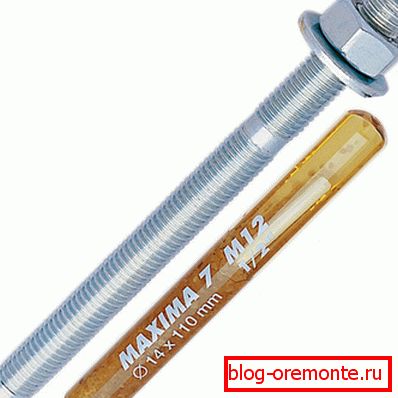Anchor for aerated concrete - features, types and purpose
As is known, aerated concrete is light and porous material, in fact, this is its main advantage. However, such a structure also has some drawbacks, in particular, a nail or a self-tapping screw will not be held in such a block. To solve the problem of fasteners, an anchor is hammered into aerated concrete.
Next, we look at what this fastener system is, what types it is and how it is mounted in aerated concrete.

General information
So, the anchor fastener consists of two main parts:
- Expansion - after installation, it changes its geometry and thereby ensures reliable anchorage of the anchor in the porous structure of the material (in the case of chemical anchors, this part in the liquid state penetrates into the pores and thereby ensures fixation).
- Inner corewhich is fixed in the spacer.
So that the fastener does not fall through the hole, the spacer part has a special rim or cuff. The length of the structure can be very different - from 40-50 mm to 250-300 mm. As a rule, the diameter does not exceed 30 mm.

Types of anchors
By the method of mounting all the anchor for aerated concrete can be divided into two types:
- Mechanical;
- Chemical.
Now consider the features of each of these species.
Mechanical
Reliability of fixing a mechanical anchor is achieved by spreading the fastener in the thickness of the porous array. As a rule, the fastener consists of a tube that is inserted into the hole and changes its geometry as a result of screwing or plugging the inner core into it.
The advantages of such fasteners include the following points:
- It is very easy to install an anchor in aerated concrete.
- Installation of the system takes a little time.
- The load is distributed evenly.
- Installation of mounted elements can be performed immediately after installation of the anchor.
- If necessary, the fastening system can be dismantled.
Installing the rods is quite simple:
- First, the hole of the desired diameter is drilled. (See also the article How to drill a concrete wall with a drill: features.)
- Then the tube is inserted.
- The final step is to install an expansion rod with your own hands, which can become clogged or screwed.
Tip! If you drill aerated concrete is not difficult, then with more solid materials problems may arise, for example, if part of the wall is concrete. In this case, use diamond drilling holes in the concrete.

Many well-known manufacturers, such as HILTI, Fisher GB, HPD, etc., guarantee the quality of the products offered. As a rule, such anchors are made of high strength stainless steel. However, despite this, they are still susceptible to oxidation, which is perhaps their main drawback.
When building houses from gas blocks with the execution of the lining of aerated concrete with various facade materials, anchors are used - flexible connections. The production of such fasteners engaged Russian company

Such anchors are made of basalt plastic rods. For better adhesion with the solution, they are sandy. In addition, the flexible connection of stainless steel produces German company Bever.
Another common type of fasteners for aerated concrete is the butterfly anchor. Its fixation is carried out at the expense of segments-petals, which reliably "hold" for the porous material. In the market this product is represented by the manufacturer MUPRO.

Chemical
The principle of fixation of chemical fasteners is based on the fact that a binder penetrates into a porous material, whether it is gas or foam concrete, which solidifies and forms a monolithic compound. Such a system is used less frequently, but one cannot do without it if the anchor has to withstand heavy loads.
The capsule includes organic resins and polymers.
Installation instructions for such anchors are as follows:
- The first step is to drill a hole in the porous material. To do this, you can use a conventional drill.
- Then an ampoule containing a special chemical composition is inserted into the hole.
- Next, the ampoule must be broken and a metal rod inserted into the hole.
- After that, you need to wait until the binding element hardens. It can take from several hours to days.

This system of fasteners has the following advantages:
- Tight connection;
- There are no cold bridges in the field of fasteners;
- No moisture penetrates the anchor;
- Ability to withstand heavy loads.
Tip! In the process of mounting attachments on the walls may need to proshtrobit plot. If the walls are combined, for example, the load-bearing part is reinforced concrete, then cutting the reinforced concrete with diamond circles is the most efficient way of processing.

As for the shortcomings of this design, then they include only the impossibility of dismantling the anchor.
The most famous manufacturers of chemical fasteners are:
- HILTI;
- Massa-Henke.
Of course, the price of products from well-known companies is higher, but then you will be assured of the quality of installation systems.
Conclusion
Contrary to popular belief that it is impossible to fix anything on porous concrete, the use of anchors ensures reliable installation. Moreover, chemical systems fasteners can withstand even a fairly large load. The only thing you need to purchase products from trusted manufacturers, guaranteeing the quality of their products.
From the video in this article, you can get more information on this topic.